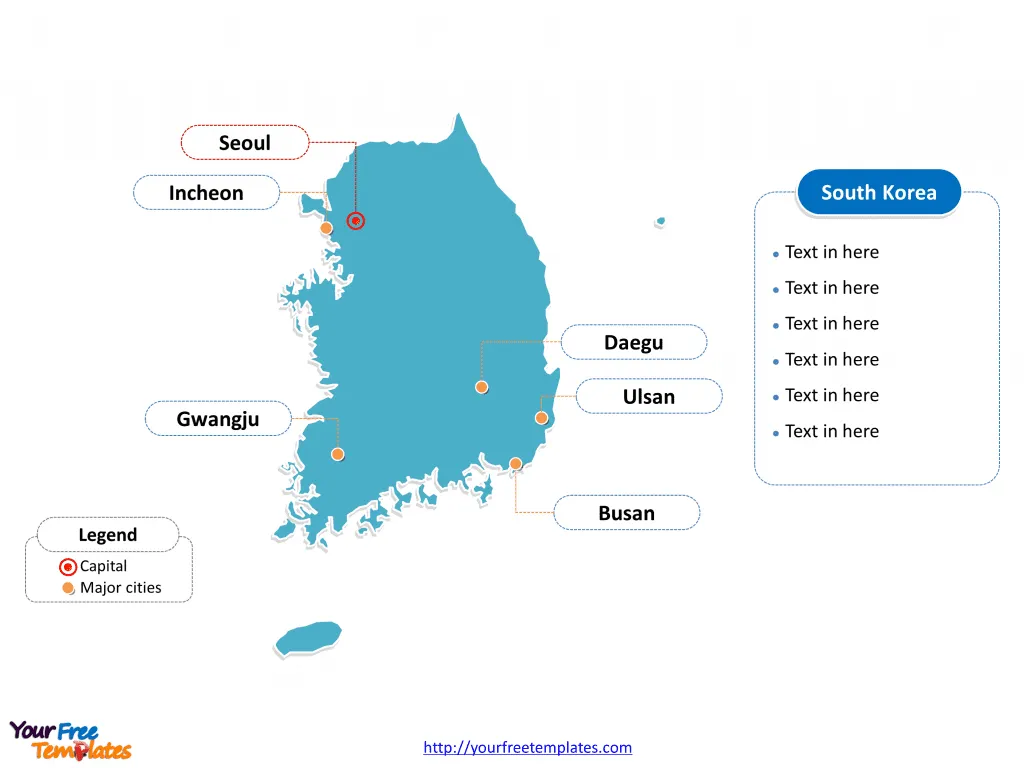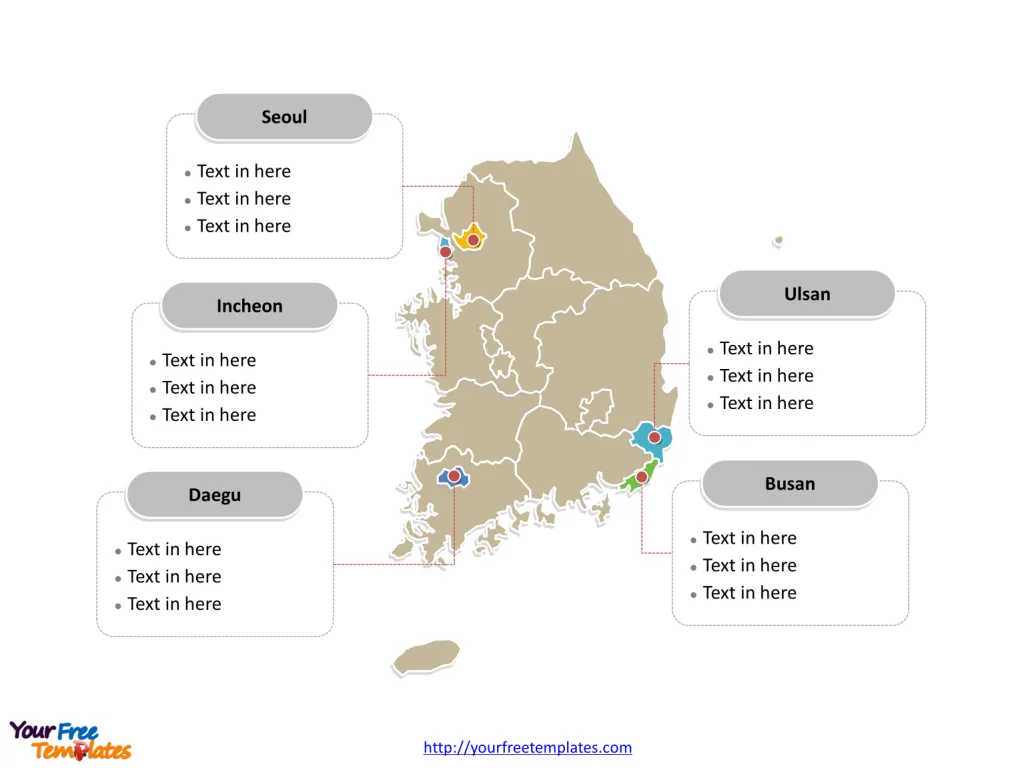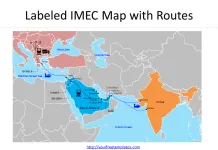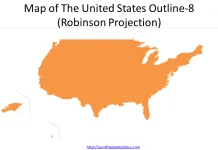The slide of South Korea Map Template includes two slides. South Korea map with 9 provinces and 8 cities, highlighting Seoul, Busan, Daegu, Incheon, Ulsan metropolitan cities. The South Korea Map outline labeled with Seoul, Busan, Incheon, Daegu, Daejeon, Gwangju, and Ulsan cities.
South Korea, officially known as the Republic of Korea, is located in East Asia, occupying the southern portion of the Korean Peninsula. It lies to the east of the Asian mainland, bordered by the Yellow Sea to the west and the Sea of Japan (East Sea) to the east. Its geographical coordinates are approximately 35°N latitude and 127°E longitude.
South Korea shares its only land border with North Korea to the north, delineated by the heavily fortified Demilitarized Zone (DMZ), making it a unique peninsula country with a singular neighbor. Despite having just one direct neighbor, South Korea’s maritime boundaries bring it in proximity to China and Japan, influencing its strategic and economic relations.
Slide 1, South Korea map outline labeled with capital and major cities.
South Korea, a vibrant nation in East Asia, is known not only for its dynamic cultural exports but also for its diverse and bustling cities. Each city has its unique charm, contributing to the country’s rich tapestry. Here, we explore some of South Korea’s major cities, including Seoul, Busan, Incheon, Daegu, Daejeon, Gwangju, and Ulsan, along with the significance of its metropolitan areas.
South Korea’s Major Cities on South Korea Map
Seoul
Seoul, the capital and the largest metropolis of South Korea, is the heart of the country’s economy, politics, and culture. As a sprawling city, it seamlessly blends ancient history with cutting-edge technology. Home to the iconic Gyeongbokgung Palace, the historic Bukchon Hanok Village, and the futuristic Dongdaemun Design Plaza, Seoul offers a glimpse into Korea’s past and future. The city is also renowned for its vibrant street food scene, extensive shopping districts like Myeongdong and Insadong, and the serene beauty of the Han River that bisects it.

Busan
Busan, South Korea’s second-largest city, is famous for its beautiful beaches, scenic mountains, and the bustling Jagalchi Fish Market. Situated on the southeastern tip of the Korean Peninsula, this port city is a gateway to a myriad of coastal attractions, including Haeundae Beach, Taejongdae Park, and the Beomeosa Temple. Busan also hosts the annual Busan International Film Festival, which is one of the most significant film festivals in Asia.
Incheon
Incheon, known for its modern Incheon International Airport, is a major port city adjacent to Seoul. Its importance stems from its role as a transportation hub and its historical significance as the site of the Incheon Landing during the Korean War. The city is also home to the Songdo International Business District, a smart city known for its sustainable design and the Central Park.
Daegu
Daegu, located in the southeastern part of the country, is the fourth-largest city in South Korea. Known as the “Apple City” for its high-quality apples, Daegu is a center for textile industry and fashion. The city is surrounded by mountains, offering beautiful natural landscapes. Daegu’s Seomun Market, one of the largest traditional markets in Korea, is a must-visit for those looking to experience the local culture and cuisine.
Daejeon
Daejeon serves as a hub of science and education in South Korea, with the presence of the Korea Advanced Institute of Science and Technology (KAIST) and the Daejeon Government Complex. The city is strategically located at the crossroads of major transport routes, making it an accessible destination. Daejeon’s Expo Park, remnants of the 1993 Daejeon Expo, is a popular attraction.
Gwangju
Gwangju is the sixth-largest city in South Korea, known for its rich history, particularly the May 18th Democratic Uprising. It’s a city with a strong sense of community and culture, hosting various art galleries, museums, and the Gwangju Biennale, an international contemporary art exhibition. Gwangju is also famous for its cuisine, especially the spicy Gwangju kimchi.
Ulsan
Ulsan, often referred to as the industrial powerhouse of South Korea, is notable for hosting the world’s largest automobile assembly plant operated by Hyundai Motor Company, and the world’s largest shipyard, run by Hyundai Heavy Industries. Despite its industrial background, Ulsan offers natural attractions such as the Taehwagang River Grand Park and the Bangudae Petroglyphs.
Slide 2, Map of South Korea labeled with major administration districts.
South Korea is a country consisting of 9 provinces, one special self-governing province, six metropolitan cities, one special city and one metropolitan autonomous city. Namely, they are Seoul, Busan, Daegu, Incheon, Gwangju, Daejeon, Ulsan, Sejong, Gyeonggi, Gangwon, North Chungcheong, South Chungcheong, North Jeolla, South Jeolla, North Gyeongsang, South Gyeongsang, and Jeju. The most populated provinces are Ulsan, Busan, Seoul, Incheon and Daegu labeled on South Korea Map. Every individual political subdivision is an editable shape.

Major Metropolitan Cities on the South Korea map
The metropolitan cities of Seoul, Busan, Daegu, Incheon, and Ulsan hold special status in South Korea’s administrative structure, functioning as both cities and provinces. Each metropolitan city is a key economic, cultural, and political center in its respective region, contributing significantly to the national landscape.
In conclusion, South Korea’s cities are as diverse as they are dynamic, each playing a crucial role in the fabric of the nation. From the ancient palaces of Seoul to the industrial complexes of Ulsan, these cities offer a unique blend of history, culture, and innovation, making South Korea a fascinating country to explore.
Looking for Premium maps, please visit our affiliate site: https://editablemaps.com/ or https://ofomaps.com/
Size: 122K
Type: PPTX
Aspect Ratio: Standard 4:3
Click the blue button to download it.
Download the 4:3 Template
Aspect Ratio: Widescreen 16:9
Click the green button to download it.
Download the 16:9 Template














